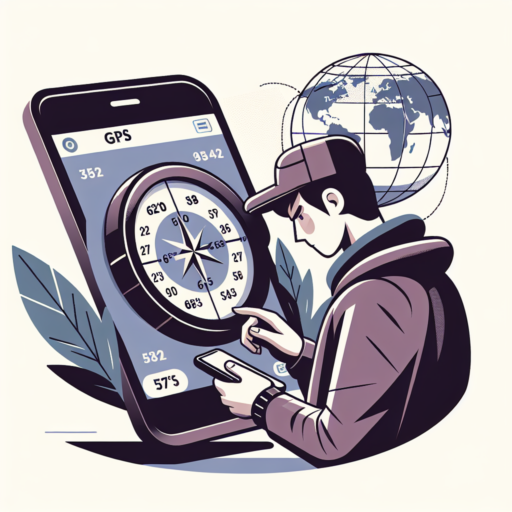Understanding GPS Coordinates: Basics and Beyond
GPS coordinates are a fundamental component of modern geography and navigation, offering a precise way to locate points on the Earth’s surface. At the core, these coordinates consist of latitude and longitude values, providing a set of numbers that can pinpoint any location worldwide. Understanding how to read and interpret these numbers not only enhances your geographic knowledge but also empowers you in various applications, from navigation to geocaching.
Decoding Latitude and Longitude
At its essence, latitude and longitude are the lines that crisscross the Earth, creating a grid that can be used to locate anything on the planet. Latitude lines run east-west but measure north-south, ranging from 0° at the Equator to 90° at the poles. Longitude lines, on the other hand, run from pole to pole but measure east-west, starting at the Prime Meridian (0° longitude) and going up to 180° in both directions. By understanding these measurements, you can start to decode the numerical language of the Earth’s surface.
Interpreting GPS Coordinates in Daily Use
Interpreting GPS coordinates might seem daunting at first, but it quickly becomes straightforward with a bit of practice. Coordinates are typically expressed in degrees (°), minutes (‘), and seconds («), with latitude values presented first, followed by longitude. For example, the GPS coordinates of the Eiffel Tower in Paris, France, are 48° 51′ 29.99″ N, 2° 17’ 40.02» E. This system allows for the precise identification of locations and is crucial for various technologies, from smartphone mapping apps to specialized navigation systems.
No se han encontrado productos.
Step-by-Step Guide on How to Read GPS Positions
Understanding how to interpret GPS coordinates properly can transform your navigation experiences, ensuring you reach your destinations accurately and efficiently. GPS positions, typically presented in latitude and longitude, are the cornerstone of modern geographical navigation. Through this guide, we’ll simplify the process into manageable steps.
Firstly, it’s crucial to comprehend the basic components of GPS coordinates. Latitude refers to the geographic coordinates that specify the north-south position on the Earth’s surface, while longitude points to the east-west location. These coordinates are usually expressed in degrees, minutes, and seconds (DMS) or in decimal degrees.
Step 1: Identifying Latitude and Longitude
Begin by looking at the first number in the GPS position, which represents the latitude. Latitudes north of the Equator are positive numbers, while those south are negative. The second number you see is the longitude, with values positive in the eastern hemisphere and negative in the western hemisphere. A GPS position might look like «41.40338, 2.17403,» indicating a location in Barcelona, Spain.
Step 2: Converting GPS Coordinates
If your GPS provides coordinates in DMS format, you might need to convert them to decimal degrees for some applications. To do this, divide the minutes by 60 and the seconds by 3600, and then add those to the degrees. This conversion can be pivotal for accurately inputting positions into certain software or online maps.
Step 3: Reading Coordinates on a Map
The final step is to apply your understanding of GPS coordinates by locating the position on a map. Today, many online maps allow you to input the decimal degrees directly, immediately showing the location. Remember, the latitude number goes first, followed by the longitude. Paying close attention to the detail of the map scale will enhance your ability to pinpoint the precise location.
By familiarizing yourself with these fundamentals, reading GPS positions becomes a straightforward task, whether you’re planning a trip, locating a specific address, or simply indulging in geographical curiosity.
Different Formats of GPS Coordinates and How to Interpret Them
Understanding the various formats of GPS coordinates is crucial for accurate navigation and geographic information systems (GIS) usage. GPS coordinates can be presented in several ways, each with its unique structure and application. Interpreting these formats correctly ensures successful mapping, navigation, and spatial analysis.
The most common format is the Decimal Degrees (DD), which is straightforward and widely used in most mapping applications today. This format expresses latitude and longitude coordinates as decimal fractions, making it particularly user-friendly and easy to input into most GPS devices and online maps. However, the precision of Decimal Degrees can vary, highlighting the importance of understanding how many decimal places are necessary for your specific application.
Understanding Degrees, Minutes, Seconds (DMS)
Another popular format is the Degrees, Minutes, Seconds (DMS). This traditional approach breaks each coordinate into degrees, minutes, and seconds, offering a more precise location pinpointing than Decimal Degrees. Interpreting DMS can seem complex at first due to its three-tiered structure, but it’s especially useful in specific fields like surveying, aviation, and maritime navigation. It’s essential to grasp how to convert between DMS and Decimal Degrees to ensure versatility across different platforms and applications.
Practical Tips for Accurately Reading GPS Positions on Various Devices
Getting accurate GPS readings on various devices, whether it’s your smartphone, smartwatch, or a dedicated GPS unit, requires some know-how and adjustments. Depending on the device, the precision of GPS positioning can greatly vary due to factors like device quality, signal interference, and settings optimization.
Understand Your Device’s GPS Capabilities
Start by familiarizing yourself with your device’s GPS features and limitations. High-end smartphones and GPS units often come equipped with advanced GPS chips that can tap into multiple satellite systems such as GPS (USA), GLONASS (Russia), and Galileo (EU). This multi-system support can enhance location accuracy. In contrast, lower-end models might rely solely on GPS, making them potentially less accurate in certain conditions. Turning on the option to use multiple satellite systems, if available, can significantly improve positioning accuracy.
Optimize Device Settings for GPS Accuracy
Another critical factor is ensuring that your device’s settings are optimized for the best GPS performance. For smartphones, this means turning off power-saving modes that may restrict GPS functionality. Additionally, regularly updating your device’s software and GPS-related apps ensures that you benefit from the latest improvements and bug fixes. For even better accuracy, calibrating the GPS according to the manufacturer’s instructions can make a substantial difference. It’s also worth noting that weather conditions and physical surroundings (such as buildings or heavy foliage) can impact GPS accuracy, so taking readings in open areas when possible is advisable.
Using Maps to Decode Your GPS Position: A Practical Approach
In today’s digital age, the ability to accurately decode your GPS position using maps is an essential skill for anyone looking to navigate unfamiliar territories or simply understand their current location with greater precision. With the right tools and a bit of know-how, transforming the numerical data provided by GPS into a comprehensible format on a map can enhance your travel experiences and geographical understanding.
GPS (Global Positioning System) technology communicates with satellites orbiting the Earth to pinpoint your exact location, represented by longitude and latitude coordinates. However, interpreting these coordinates directly can be challenging without a visual reference. That’s where maps come into play. By using mapping software or applications that integrate with GPS data, individuals can see their position depicted on a map, making it easier to comprehend their surroundings and navigate accordingly.
Steps to Decode GPS Position on Maps
- Choose the Right Mapping Software: With various mapping tools available online, such as Google Maps, OpenStreetMap, or proprietary GPS navigation systems, selecting one that suits your needs is crucial.
- Input GPS Coordinates: Once you have your preferred map open, entering the GPS coordinates into the search bar or using a ‘locate me’ feature can instantly show your position on the map.
- Zoom and Explore: Use zooming and exploring features to get a better sense of your location’s geography, nearby landmarks, and other points of interest that can aid in navigation.
Understanding the interface of mapping applications and how to effectively input and interpret GPS data can significantly improve your ability to navigate and comprehend locations globally. Whether you’re planning a trip, hiking in the wilderness, or simply trying to find a specific address, using maps to decode your GPS position is a practical approach that leverages modern technology for enhanced spatial awareness and navigation efficiency.
Essential Apps and Tools for Reading GPS Positions Like a Pro
In today’s digital age, understanding and interpreting GPS positions have become a necessity for various professions and hobbies. With a myriad of applications and tools available, it’s easier than ever to access detailed location data. However, distinguishing the most efficient and accurate tools can be challenging. This guide highlights some essential apps and tools designed to make reading GPS positions straightforward, offering functionalities that cater to both beginners and seasoned professionals.
Top-Rated GPS Positioning Apps
For those constantly on the move or looking to map their adventures, certain apps have set the standard in GPS tracking and mapping. Google Maps and Waze are prominent for everyday navigation, offering real-time traffic data and route optimization. For outdoor enthusiasts, AllTrails and GAIA GPS provide detailed topographical maps and trail information, making them invaluable tools for hikers and bikers. These apps not only help in reading GPS positions but also enhance the overall navigation experience with their user-friendly interfaces and comprehensive features.
Advanced Tools for Professionals
When precision and advanced functionality are required, professionals turn to specialized tools. Trimble offers high-accuracy GPS receivers and software tailored for surveying and construction projects. Similarly, Garmin devices are widely recognized for their reliability in outdoor and maritime environments, offering detailed mapping and robust GPS capabilities. These tools and devices offer functionalities like waypoint marking, track recording, and elevation profiling, essential for tasks that demand high precision.
In embracing these essential apps and tools, reading GPS positions becomes a skill accessible to anyone. Whether you’re a casual traveler, an adventurous explorer, or a professional requiring pinpoint accuracy, the right application or device can significantly enhance how you interact with the world’s geography. Integrating these tools into your toolkit will ensure you’re equipped to read GPS positions accurately, transforming the way you navigate and explore your surroundings.
Common Mistakes to Avoid When Reading GPS Positions
Understanding the intricacies of Global Positioning System (GPS) readings is essential for accurate navigation and positioning. However, even the most experienced users can fall prey to common pitfalls that may lead to errors in location interpretation. Recognizing and avoiding these mistakes is key to leveraging GPS technology effectively.
Ignoring Signal Interference
One of the first mistakes often overlooked is ignoring potential signal interference. Urban environments, dense forests, and even your own vehicle can obstruct GPS signals, leading to inaccurate readings. It’s vital to be aware of your surroundings and understand that certain materials or locations might interfere with your GPS device’s ability to receive a clear signal.
Overreliance on Single Data Points
Another common error is the overreliance on single data points instead of looking at a series of data for patterns or consistency. GPS data can occasionally display outliers due to various reasons such as atmospheric conditions, satellite positions, or technical glitches. Users should look for consistency in readouts over time to verify the accuracy of their GPS positions.
Not Updating GPS Software Regularly
Failure to update the GPS software can also lead to significant inaccuracies in GPS readings. Manufacturers regularly release updates that improve accuracy, add new satellites, or correct bugs that may affect performance. Ensuring your device is up to date is a simple yet crucial step in avoiding common mistakes in reading GPS positions.
Real-Life Applications of GPS Position Reading Skills
Understanding GPS position reading skills has become fundamental in our technologically driven world. These abilities not only enhance our navigation capabilities but also play a crucial role in various sectors that impact our daily lives. From enabling precise location tracking to facilitating advanced research, the mastery of GPS position reading unfolds myriad practical applications.
Enhancing Emergency Response Services
Emergency services have significantly benefitted from GPS technology. By accurately reading GPS positions, responders can reach incident sites more quickly and efficiently. This precision is particularly vital in urgent situations where every second counts, such as in search and rescue operations or when dispatching ambulances to remote locations.
Improving Agricultural Efficiency
Another significant application of GPS position reading skills is found in the agricultural sector. Farmers and agronomists utilize GPS technology to practice precision farming. By understanding precise coordinates, they can monitor crop health, optimize planting strategies, and manage resources more effectively. This not only leads to increased crop yields but also promotes sustainable farming practices by minimizing waste and environmental impact.
Facilitating Scientific Research
Scientific research, across various domains, leverages GPS position reading in ground-breaking ways. Environmental scientists, for instance, track animal migration patterns and study climate change effects by pinpointing exact locations. Archaeologists, on the other hand, rely on GPS to uncover ancient sites without disturbing the surrounding area. The accuracy provided by GPS technology thus enables a deeper understanding of our world and its history.
Frequently Asked Questions About Reading GPS Coordinates
Understanding how to read GPS coordinates is essential for navigation, geocaching, and many other outdoor activities. GPS coordinates are often presented in different formats, which can be confusing for newcomers. The most common questions revolve around interpreting these formats, accuracy, and how to input coordinates into devices. By grasping the basics, you can make the most out of your GPS device for a seamless navigation experience.
What Are The Different Formats of GPS Coordinates?
Diving into the world of GPS coordinates, you’ll encounter several formats. The most frequently seen are Degrees, Minutes, and Seconds (DMS), Decimal Degrees (DD), and Universal Transverse Mercator (UTM). Each format serves different purposes and is used based on the specificity needed or the device’s input requirements. Recognizing the distinction between these formats is crucial for accurately inputting and interpreting your coordinates.
How To Convert Between GPS Coordinate Formats?
Converting between GPS coordinate formats might seem daunting, but it’s a vital skill for navigators. With the aid of online tools and apps, the process becomes straightforward. The key is understanding the basic structure of each format. For instance, converting from DMS to Decimal Degrees requires combining the degrees with fractions of a minute and second, then adjusting for the hemisphere. This conversion ensures precision and accuracy in your navigational endeavors.
The challenge of accurately reading and utilizing GPS coordinates can be mitigated with practice and the correct knowledge. As each format has its use case, understanding when and how to use them allows for improved navigation and geographic data management. Whether you’re trekking in the wilderness or marking locations for work, a solid grasp on GPS coordinates will enhance your spatial orientation and decision-making on the go.
Advancing Your Skills: From Reading GPS Positions to Navigation Mastery
Embarking on the journey from simply reading GPS positions to achieving navigation mastery is an empowering process that integrates technology, skill, and a deep understanding of your surroundings. In the digital age, GPS devices have become ubiquitous, guiding us to our destinations with turn-by-turn directions. However, to transition from reliance on these devices to a comprehensive grasp of navigation, one must delve deeper into the intricacies of GPS data interpretation and its practical applications in real-world navigation.
Understanding the fundamentals of GPS technology is the first step toward enriching your navigational skills. GPS, or Global Positioning System, utilizes a network of satellites orbiting the Earth to provide precise location data. By learning how to interpret longitude, latitude, and even altitude readings from your GPS device, you’re laying the groundwork for advanced navigation techniques. This knowledge not only improves your confidence in handling technology but also equips you with the skills to navigate without it should the need arise.
Mastering navigation entails more than just interpreting digital maps and coordinates; it involves a holistic approach to understanding your environment. Techniques such as reading topographical maps, recognizing landmarks, and estimating distances become invaluable. These skills enhance your ability to make informed decisions about your route, adjusting to changes in terrain or weather conditions effectively. Engaging with the natural world through these practices fosters a deeper connection to the environment, turning every journey into a learning experience.




